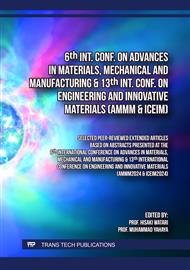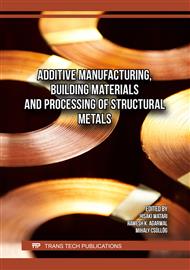p.3
p.9
p.15
p.23
p.31
p.37
p.53
p.61
p.67
Microstructural Evolution and Corrosion Behavior of Selective Laser Melted 17-4 pH Stainless Steel
Abstract:
17-4 Precipitation hardenable (PH) stainless steel (SS) is useful for applications that require a combination of high strength and corrosion resistance. However, when produced through selective laser melting (SLM), it has a distinct microstructure with significant composition and phase variations based on the process parameters and post processing heat treatment conditions. Therefore, the present study examines how process parameters, such as scanning speed and hatch distance, affect the microstructural, and corrosion characteristics of additively manufactured (AM) 17-4 PH stainless steel samples. Post-processing heat treatment resulted in a uniform and reproducible microstructure in SLM samples. Heat-treated AM samples were assessed in a 3.5 wt. % NaCl solution using electrochemical impedance spectroscopy (EIS). The specimen with an energy density of 39.06 J/mm³ exhibited the lowest open circuit potential value, indicating a favorable tendency to form a passive film. The sample with 66.96 J/mm³ exhibits enhanced corrosion resistance attributed to robust protective performance facilitated by a dense network of precipitates and finer grain size. This heightened resistance is further supported by the sample's highest corrosion layer resistance and charge transfer resistance.
Info:
Periodical:
Pages:
31-36
Citation:
Online since:
June 2025
Authors:
Price:
Сopyright:
© 2025 Trans Tech Publications Ltd. All Rights Reserved
Share:
Citation:



